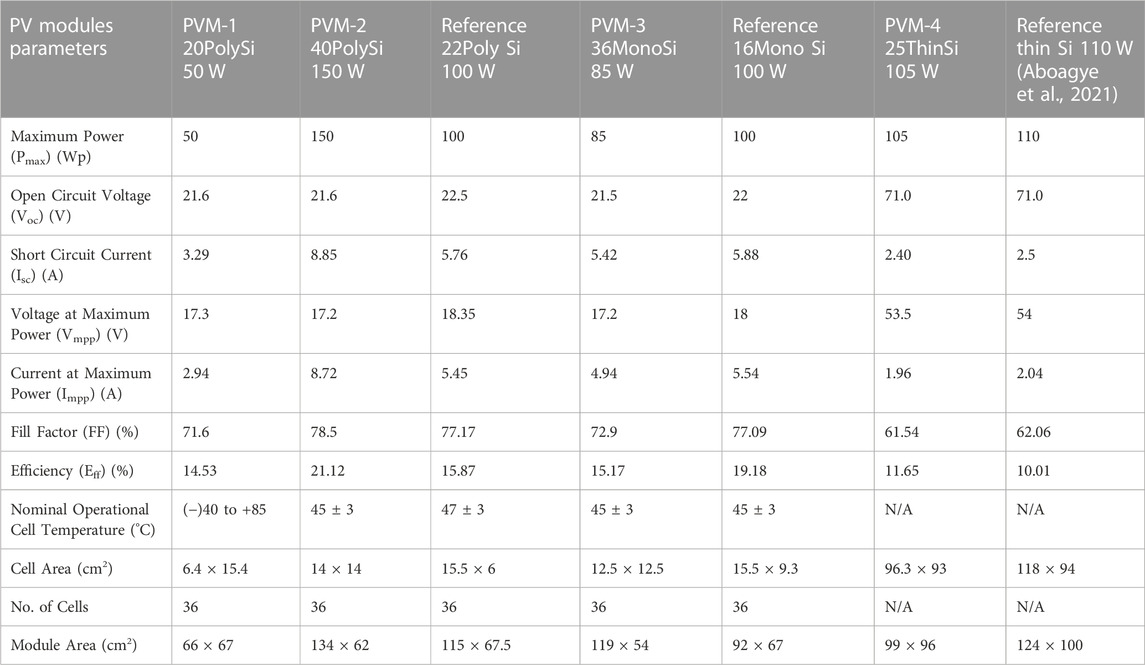- 1Department of Physics, Bangabandhu Sheikh Mujibur Rahman Maritime University, Dhaka, Bangladesh
- 2School of Energy and Environment, City University of Hong Kong, Kowloon, Hong Kong SAR, China
- 3Center for Research and Innovation in Science, Technology, Engineering, Arts, and Mathematics (STEAM) Education, HICCER—Hariterde International Council of Circular Economy Research, Palakkad, Kerala, India
- 4Department of Electrical Engineering, Graphic Era (Deemed to Be University), Dehradun, India
- 5Graphic Era Hill University, Dehradun, India
- 6Applied Science Research Center, Applied Science Private University, Amman, Jordan
- 7Department of Electrical Engineering, College of Engineering, Prince Sattam Bin Abdulaziz University, Al-Kharj, Saudi Arabia
- 8Department of Electrical Power and Machines Engineering, Faculty of Engineering, Helwan University, Helwan, Egypt
- 9Electrical Engineering Department, Faculty of Engineering, Aswan University, Aswan, Egypt
This study evaluates the degradation of mono, poly, and thin-film silicon solar photovoltaic (PV) modules through visual and electrical measurements in Dhaka’s tropical wet and dry climate conditions. For this, several sites of rooftop solar PV installations in Dhaka, aged at least 5 years, were selected for field investigation. A visible inspection for visual degradation followed by experimental testing on various electrical characteristics of the PV modules installed on the rooftop using a portable Seaward I–V Tracer for measuring the electrical degradation was done. The electrical data were used to evaluate the degradation of short circuit current, open circuit voltage, fill factor, and maximum power in the field as compared to the nameplate values. Experimental results showed the varying types of visual degradation types such as visible cracks, snail trails, moisture intrusion, front glass, and discoloration for the investigated PV modules. The degradation of PV modules in terms of short circuit current was 0.7%/year for 85Wp mono c-Si, 7.6%/year for 150Wp poly c-Si, and 9.7%/year for 105Wp silicon thin-film, respectively. We believe this study would guide the maintenance of the solar PV systems installed on Dhaka city’s rooftop buildings.
1 Introduction
The National Energy Policy of Bangladesh-2010 (NEP-2010) had set targets to generate 5% of the total electricity from renewable energy resources by 2015, 10% by 2020, and 17% by 2041 to reduce greenhouse gas emissions (National Energy Policy of Bangladesh-2010, 2010). At present, the renewable energy share of the national electricity production capacity is 3% (Uddin et al., 2019). In total share of 3%, hydro, solar, and wind energy shares are 60%, 39.5%, and 0.5%, respectively (Uddin et al., 2019). This suggests that after hydropower, solar energy is the fastest-growing renewable energy in Bangladesh’s energy sector. Also, the government’s set targets for solar energy dominate the other renewable energy sources (Sustainable and Renewable Energy Development Authority SREDA, 2019), see Figure 1.
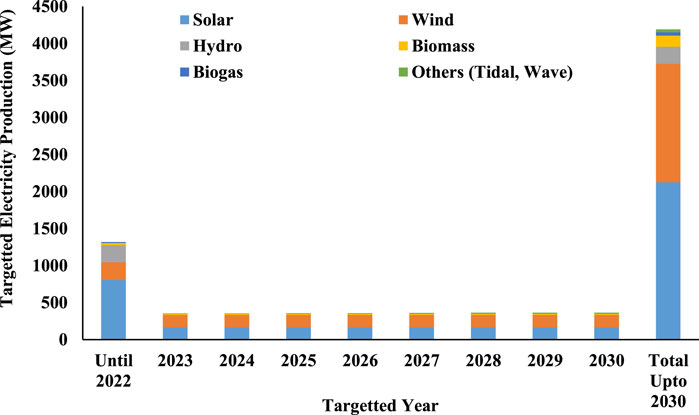
FIGURE 1. Year-wise set targets for increasing renewable share in Bangladesh’s energy mix. Drawn based on data source (Sustainable and Renewable Energy Development Authority SREDA, 2019).
Since then, solar PV has emerged as a popular source of electricity and is even become popular in remote areas with the government initiative under the motto of ‘access to electricity for all’ (Sustainable and Renewable Energy Development Authority SREDA, 2019). The PV systems that have been deployed in Bangladesh are i) solar home systems, ii) solar systems on the roof of an industrial and commercial building, iii) solar irrigation, iv) solar street lighting, v) large scale solar power plants, and vi). Solar-based electric vehicle charging stations (Sustainable and Renewable Energy Development Authority SREDA, 2019). These PV systems showed a great scope in favoring the SDG7 criteria (Kumar et al., 2020). Though it favors the SDG7 criteria, concerns related to stable long-term performance in terms of energy generation were raised (Kumar et al., 2020). This is mainly due to the degradation that is often observed in solar PV modules and is PV cell (monocrystalline silicon (mono c-Si), polycrystalline silicon (poly c-Si), and thin-film) technology dependent, sensitive to climatic conditions and surrounding influences (Kumar et al., 2019a). During the PV module’s lifetime, its energy generation levels degrade yearly at an average rate of 0.5% to higher, depending on the cell technology and the installation location (Kumar and Malvoni, 2019). From a maintenance point of view, degradation plays a crucial role; also, some evidence shows the decline in revenues due to PV degradation in solar power plants (Kumar et al., 2019b). So it is imperative to measure the degradation, which can be done mainly by conducting visual (Chekired et al., 2021) and electrical performance experiments (Rajput et al., 2019) and, in some cases prediction algorithms (Kumar and Subathra, 2019). However, experimental studies are more notable and mostly confined to specific geographical locations. For instance, for degradation in mono c-Si, studies on 7 years aged modules in Singapore (Luo et al., 2019), 5 years aged modules in India (Dubey et al., 2017), 5 and 10 years aged modules in Algeria (Charrouf et al., 2017), 3 years aged modules in Senegal (Ndiaye et al., 2015), 12 years aged modules in Ghana (Aboagye et al., 2021), and 22 years aged modules in Spain (Lillo-Sánchez et al., 2021) are notable. For degradation in poly c-Si, studies on 3 years aged modules in Indonesia (Sinaga et al., 2019), 9 years aged modules in Malaysia (Islam et al., 2018), and 3 years aged modules in India (Dubey et al., 2017) are notable. Similarly, few studies exist on solar PV module types such as CIGS, CdTe, and HIT (Dubey et al., 2017). However, in our brief literature study, we observed that studies confining to Bangladesh on solar PV degradation do not exist, and we believe it is important to investigate as Bangladesh is trying to enhance solar share in the national energy mix.
Hence, this research aims to estimate the degradation in various PV modules (mono c-Si, poly c-Si, and thin-film silicon) operating in a real-time environment for at least 5 years through visual and electrical inspection methods in Bangladesh’s geographical and environmental context, especially for Dhaka city.
2 Methods
2.1 Detail of test sites
This study considered 4 rooftop solar PV installation sites (1 mono c-Si, 2 poly c-Si, and 1 thin-film silicon); see Table 1 for more details on the test sites. These test sites fall under the Tropical savanna climate (Aw) as per the Köppen-Geiger climate classifications (Köppen, 1884). In these test sites as per the local weather station, the average temperature in summer is 40°C; in monsoon, it is 35°C; and in winter, it is 25°C. The average wind speed in summer is 10 km/h; in monsoon, it is 6 km/h; and in winter, it is 4 km/h. The average solar irradiation in summer is 900 Wm-2; in monsoon, it is 1,000 Wm-2; and in winter, it is 800 Wm-2. The average humidity in summer is 60%; in monsoon, it is 80%, and in winter, it is 55%. The average rainfall in summer is 90 mm; in monsoon, it is 90 mm; and in winter, it is 10 mm. The average sunshine hours in summer are 10 h/day; in monsoon and winter, they vary from 7–8 h/day.
The manufacturer-provided data for each type of PV module is given in Table 2. Mono and poly c-Si reference PV modules were bought from the market for comparison. For the thin film module, 110Wp PV modules data from the reference by (Ustun et al., 2019) was used.
2.2 Experimental instrumentation setup
The electrical data under sunlight were measured using the PV-200 Seaward I–V tracer from Seaward Electronic Limited, UK (PV-200 Seaward, 2023) (see Table 3 for technical features). The solar irradiation, PV module temperature, and ambient temperature were measured using wireless Solar Survey 200 from Seaward Electronic Limited, UK (PV-200 Seaward, 2023). The current-voltage (I–V) data was measured by connecting the I–V tracer standard probes with the connectors in the back terminal of the PV module of interest. The data acquisition from the PV modules under sunlight was carried out following the standard operating procedure of the I–V tracer. The PV modules were isolated from the array at the beginning of the process to ensure safety. The radiation flux meter was kept at the same plane with the PV module using a clamp; thus, the PV module and the solar irradiation meter received an identical amount of sunlight. The suction-type temperature sensor was connected to the rare side of the PV module, and the ambient temperature sensor kept hanging around the PV module.
2.3 Translation of experimental data to standard testing condition (STC) values
The I-V data processing was performed using the Seaward Solar Chart tool from Seaward Electronic Limited, UK (PV-200 Seaward, 2023). The transfer of I–V data from the survey meter to a computer was completed by using the SolarCert data logger software tool (SolarCert, 2023). The software allows us to plot the I–V graph and power-voltage (P-V) graph under STC following Procedure 1a of IEC 60891 (Photovoltaic devices, 2009; Li et al., 2021).
3 Results and discussions
3.1 Visual inspections results
The degradation of PV modules can be categorized into four major categories, i) degradation of packaging material, ii) loss of adhesion, iii) degradation of module interconnects, and iv) degradation of the solar cell material (Sinha et al., 2020). Some of these degradations lead to visible changes in the module and can be detected by visual inspection of the module without doing any electrical characterization of the module (Meena et al., 2022). The images of the various visual degradations observed in our investigation are given in Figure 2, which are inline with other visual degradation studies in literature (Menoufi et al., 2017; Ingenhoven et al., 2019; Tanesab et al., 2020; Meena et al., 2022). For instance, large visible cracks (Figure 2A), discoloration (Figure 2B), glass degradation and front-side delamination (Figure 2C), moisture and dust accumulation (Figure 2D), snail tracks (Figure 2E), and a minor cracks (Figure 2F). Based on our observation, the visual degradation observed in studied PV modules is classified as per the variations shown in literature and presented in Table 4. Overall, it was observed that all three types of PV modules (mono c-Si, poly c-Si, and thin-film silicon) are subject to degradation, though poly c-Si modules suffer more.
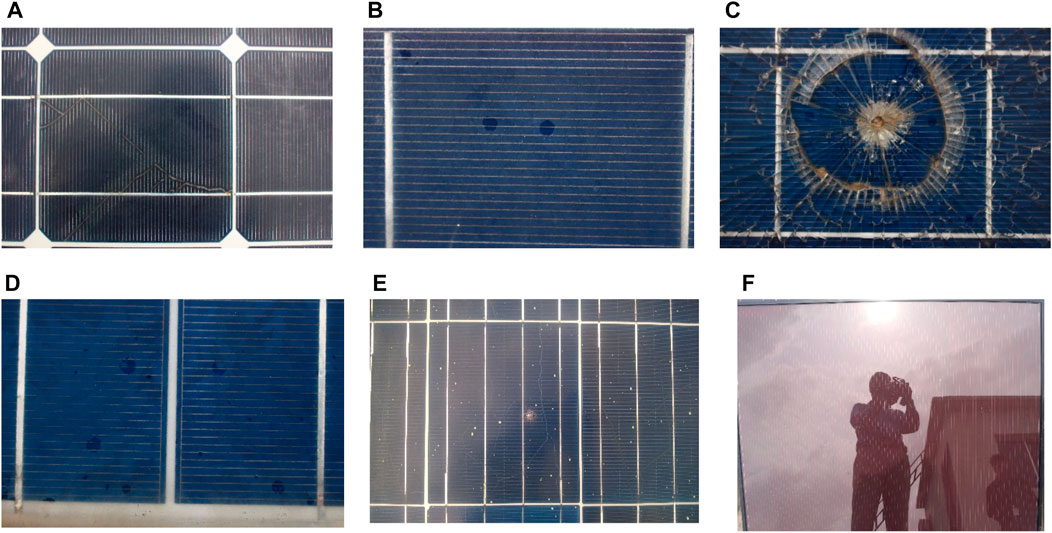
FIGURE 2. Various visual degradations observed in PV modules in rooftop solar power plants in building of Dhaka City. (A) PVM-3 36MonoSi100W; (B) PVM-1 20PolySi50W; (C) PVM-1 20PolySi50W; (D) PVM-2 40PolySi150W; (E) PVM-2 40PolySi150W; (F) PVM-4 25ThinSi105 W.
3.2 Electrical inspections results
The comparisons of various electrical parameters monitored for degradation analysis are shown in Figure 3. Figure 3 shows the results for temperature, open circuit voltage, short circuit current, voltage at maximum power, current at maximum power, fill factor, maximum power, and efficiency for the investigated mono c-Si, poly c-Si, and thin-film silicon solar PV module types. Each bar chart in Figure 3 shows 3 bars corresponding to the measured data (blue), STC data (green), and nameplate data (brown).
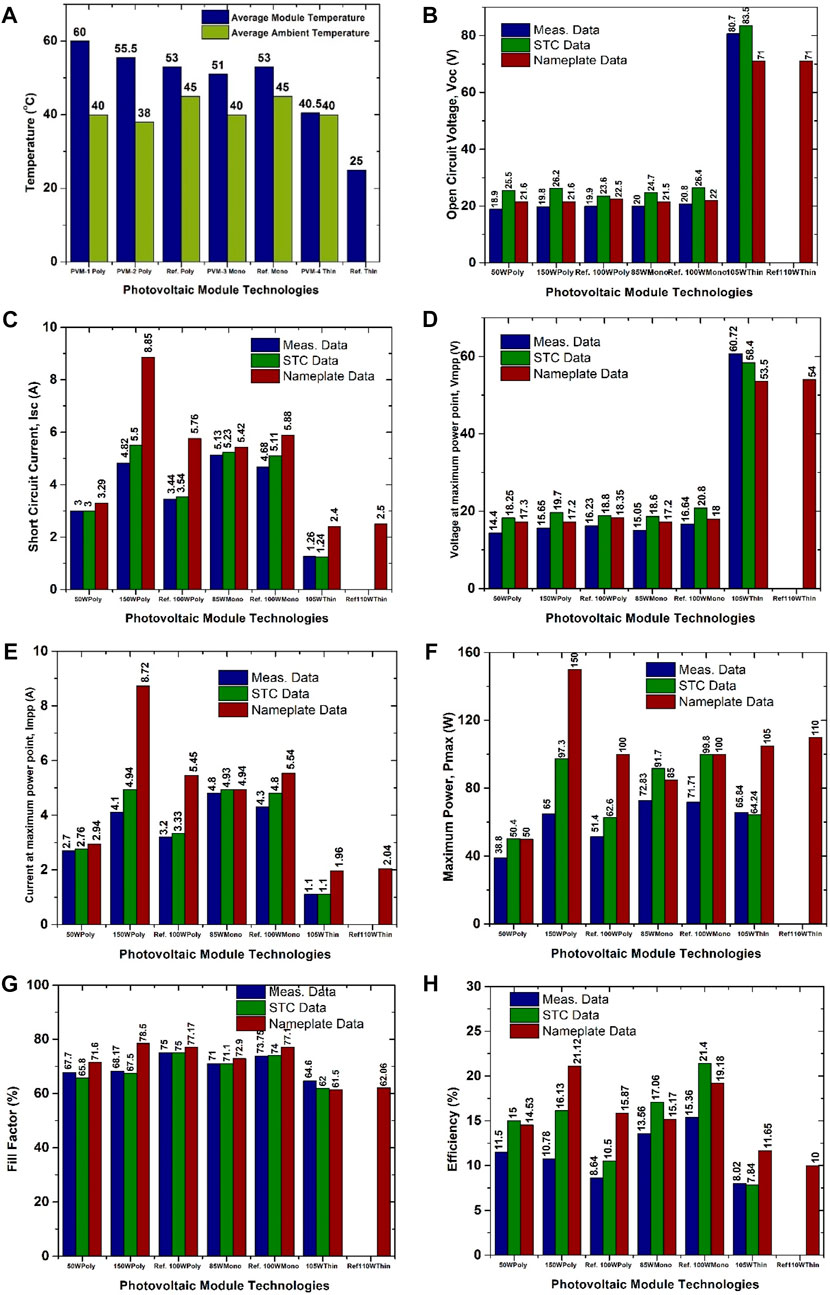
FIGURE 3. Observed degradation characteristics of mono c-Si, poly c-Si, and thin film silicon solar PV modules. (A) Ambient and module temperature; (B) Open circuit voltage; (C) Short circuit current; (D) Voltage at maximum power; (E) Current at maximum power; (F) Maximum power; (G) Fill factor; (H). Efficiency.
3.2.1 Module temperature
Figure 3A shows the average PV module temperature compared to the ambient temperature. The maximum and minimum temperature of the poly c-Si PV module was 67°C and 53°C for the times between 12:00 H −14:00 H under the irradiation of 961.8 W m-2. The average mono c-Si PV modules temperature was 51°C under the irradiation of 959.2 W m-2. The average thin-film module temperature was similar to the ambient temperature of 40°C under the irradiation of 911.8 W m-2. At the temperature range of 67°C–50°C, PV modules are subject to high thermal stress (Kurtz et al., 2009; Vaillon et al., 2020). The variations in the PV module’s temperature are due to cooling under natural wind flow (Dwivedi et al., 2020; Amber et al., 2021).
3.2.2 Electrical characteristics
As shown in Figure 3B, the open circuit voltage (Voc) at STC of each module compared to the nameplate data is higher; this is due to the fact that the operating temperatures of these modules are higher than 25°C and inline with literature evidence as suggested by (Chattopadhyay et al., 2014). As a consequence of this higher open circuit voltage, the short circuit current (Isc) at STC of each module is lower than the nameplate data; see Figure 3C. This reduction in the short circuit current (Isc) causes a decrease in the fill factor, as shown in Figure 3G. The above argument is consistent with the voltage at the maximum power point and current at the maximum power point, as shown in Figure 3D and (E). The maximum power of PV modules is significantly less than the nameplate data of PVM-2-40 PolySi- 150 W as shown in Figure 3F. This may be due to the presence of inactive cells in the module, which can explain the lower short circuit current for the same module, as shown in Figure 3C. The efficiency versus PV technology plot shown in Figure 3H represents the performance of the PV modules in terms of efficiency.
3.2.3 Analysis of degradation
The short circuit current, shown in Figure 3C, and the fill factor, shown in Figure 3F of PV modules, are considered for estimating the degradation in this study following the procedure proposed mentioned by (Dhoke et al., 2018). The degradation of short circuit current and Fill Factor is evaluated for the PV modules with 5 years of field exposure. Table 5 shows the degradations of 5 years aged PV modules in Dhaka, Bangladesh. The data in Table 5 shows that the short circuit current of high power poly c-Si PV module suffers more degradation than lower powered PV module. This is due to the fact that the high-powered module generates more current, which introduces high current and induces degradations, which is in accordenace with literature as suggested by (Dhimish and Tyrrell, 2022). The thin-film silicon solar PV module shows 9.66% degradation in the short circuit current. Thin-film PV modules are expected to be more affected by photo-induced degradation.
Table 6 shows the rate of silicon PV module performance degradation in terms of short circuit current, published in the literature, along with the data from this study. The mono c-Si PV modules are more resilient to the environment of Bangladesh than poly c-Si and thin film silicon modules; thus, the degradation rate is around 1%/year.
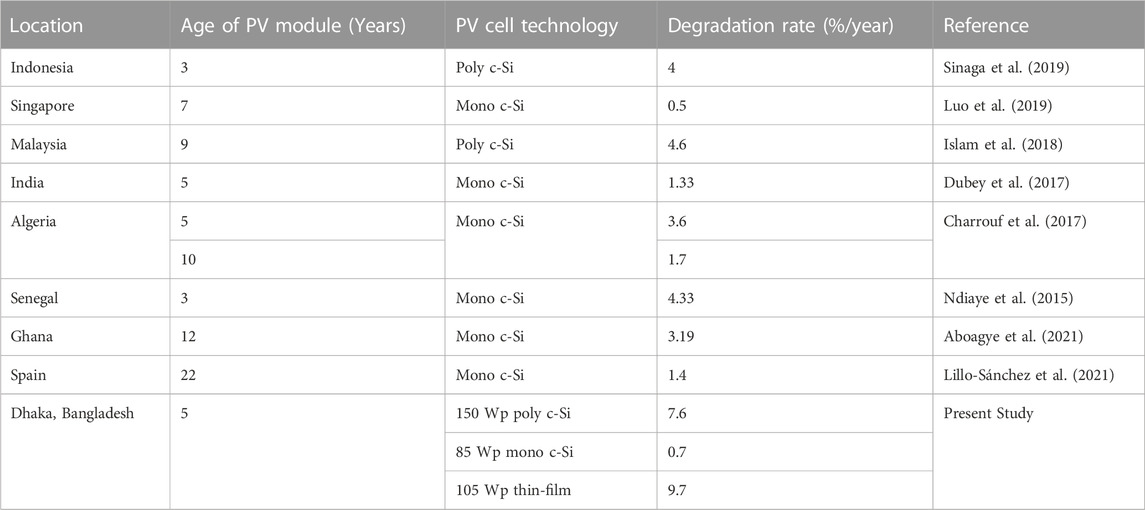
TABLE 6. Rate of silicon solar PV module performance degradation in terms of short circuit current in literature.
4 Conclusion
The degradation of three different types of PV module technologies widely used in Dhaka city’s rooftop solar plants was evaluated under visual and electrical inspection methods. This study considered 5 years old rooftop solar installations because of the availability of data. The PV modules showed clear signs of visual degradation, such as visible cracks, snail trails, moisture intrusion, front glass damage, and discoloration of contacts; however, it was not the same for all the three types of PV technologies investigated, and at the same, it was observed visual degradations intensity was higher for poly c-Si followed by mono c-Si and thin-film silicon. The electrical inspection showed a degradation of 0.7%/year for 85Wp mono c-Si, 7.6%/year for 150Wp poly c-Si, and 9.7%/year for 105Wp silicon thin-film. During our investigation, we also identified that the PV modules were not regularly cleaned or monitored, so the accounted degradation may vary if inspected for the frequently maintained modules, which are hard to find in Dhaka city. Also, frequent monitoring options were not clear on these sites, as there were no promised options by the installers during installation to identify and replace faulty modules and for regular maintenance. So, we believe this study’s results reveal the importance of maintenance, especially from a degradation point of view, and will encourage appropriate measures such as bringing awareness on promoting consumer-involved maintenance after proper training; installers’ responsibility to maintain the solar power plants by charging some premium from the consumers. At the same time, these results could trigger and lead to initiations on degradation discounted feed-in tariffs in the electricity policy.
Data availability statement
The raw data supporting the conclusion of this article will be made available by the authors, without undue reservation.
Author contributions
AH and NM formulated the concept and work schedule for the experiments. AH performed the ground level experiments followed by data analysis by NM. Validation and visualization done by AH and NM. Original manuscript writing followed by revisions during the peer review process done by AH and NM. MB, MA, ME, and SK supported the experimental process, funding for experiments followed by further improvements in manuscript revisions.
Funding
This research is funded by Prince Sattam Bin Abdulaziz University, Grant Number IF-PSAU-2021/01/18921.
Acknowledgments
The authors extend their appreciation to the Deputyship for Research & Innovation, Ministry of Education in Saudi Arabia, for funding this research work through the Project Number (IF-PSAU-2021/01/18921). The author would like to thank Professor Dr. Altaf Hussain and Professor Dr. Brij Mohan Arora for their constant guidance during the work. The author would like to thank Post Graduate Research Management and Technology Transfer Center, Bangabandhu Sheikh Mujibur Rahman Maritime University, Dhaka, Bangladesh, for the research facility.
Conflict of interest
The authors declare that the research was conducted in the absence of any commercial or financial relationships that could be construed as a potential conflict of interest.
Publisher’s note
All claims expressed in this article are solely those of the authors and do not necessarily represent those of their affiliated organizations, or those of the publisher, the editors and the reviewers. Any product that may be evaluated in this article, or claim that may be made by its manufacturer, is not guaranteed or endorsed by the publisher.
References
Aboagye, B., Gyamfi, S., Ofosu, E. A., and Djordjevic, S. (2021). Degradation analysis of installed solar photovoltaic (PV) modules under outdoor conditions in Ghana. Energy Rep. 7, 6921–6931. doi:10.1016/j.egyr.2021.10.046
Amber, K. P., Akram, W., Bashir, M. A., Khan, M. S., and Kousar, A. (2021). Experimental performance analysis of two different passive cooling techniques for solar photovoltaic installations. J. Therm. Anal. Calorim. 143, 2355–2366. doi:10.1007/s10973-020-09883-6
Charrouf, O., Betka, A., hadef, H., Djebabra, M., and Tiar, M. (2017). AIP Conf. Proc. 1814, 020030.
Chattopadhyay, S., Dubey, R., Kuthanazhi, V., John, J. J., Solanki, C. S., Kottantharayil, A., et al. (2014). Visual degradation in field-aged crystalline silicon PV modules in India and correlation with electrical degradation. IEEE J. Photovoltaics 4, 1470–1476. doi:10.1109/jphotov.2014.2356717
Chekired, F., Boudjelthia, E. A. K., Mehareb, F., and Chahtou, A. (2021). “Visual degradation of PV modules after 30 Years of exposure in Algeria,” in Artificial intelligence and renewables towards an energy transition (Springer International Publishing), 4, 811–821.
Dhimish, M., and Tyrrell, A. M. (2022). Power loss and hotspot analysis for photovoltaic modules affected by potential induced degradation. npj Mater Degrad. 6, 11–18. doi:10.1038/s41529-022-00221-9
Dhoke, A., Sharma, R., and Saha, T. K. (2018). PV module degradation analysis and impact on settings of overcurrent protection devices. Sol. Energy 160, 360–367. doi:10.1016/j.solener.2017.12.013
Dubey, R., Chattopadhyay, S., Kuthanazhi, V., Kottantharayil, A., Solanki, C. S., Arora, B. M., et al. (2017). Comprehensive study of performance degradation of field-mounted photovoltaic modules in India. Energy Sci. Eng. 5, 51–64. doi:10.1002/ese3.150
Dwivedi, P., Sudhakar, K., Soni, A., Solomin, E., and Kirpichnikova, I. (2020). Advanced cooling techniques of P.V. Modules: A state of art. Case Stud. Therm. Eng. 21, 100674. doi:10.1016/j.csite.2020.100674
Hossion, M. A. (2020). Visual and electrical degradation data of five years aged rooftop photovoltaic modules. Data Brief 31, 105762. doi:10.1016/j.dib.2020.105762
Ingenhoven, P., Belluardo, G., Makrides, G., Georghiou, G. E., Rodden, P., Frearson, L., et al. (2019). Analysis of photovoltaic performance loss rates of six module types in five geographical locations. IEEE J. Photovoltaics 9, 1091–1096. doi:10.1109/jphotov.2019.2913342
Islam, M. A., Hasanuzzaman, M., and Abd Rahim, N. (2018). Investigation of the potential induced degradation of on-site aged polycrystalline PV modules operating in Malaysia. Measurement 119, 283–294. doi:10.1016/j.measurement.2018.01.061
Kumar, N. M., Chopra, S. S., Chand, A. A., Elavarasan, R. M., and Shafiullah, G. M. (2020). Hybrid renewable energy microgrid for a residential community: A techno-economic and environmental perspective in the context of the SDG7. Sustainability 12 (10), 3944. doi:10.3390/su12103944
Kumar, N. M., Gupta, R. P., Mathew, M., Jayakumar, A., and Singh, N. K. (2019). Performance, energy loss, and degradation prediction of roof-integrated crystalline solar PV system installed in Northern India. Case Stud. Therm. Eng. 13, 100409. doi:10.1016/j.csite.2019.100409
Kumar, N. M., and Malvoni, M. (2019). A preliminary study of the degradation of large-scale c-Si photovoltaic system under four years of operation in semi-arid climates. Results Phys. 12, 1395–1397. doi:10.1016/j.rinp.2019.01.032
Kumar, N. M., Prabaharan, N., Jerin, A. R. A., and Jayakumar, A. (2019). Impact of performance degradation and capital subsidy on the revenue of rooftop PV system. Int. J. Renew. Energy Res. 9 (1), 128–136.
Kumar, N. M., and Subathra, M. S. P. (2019). Three years ahead solar irradiance forecasting to quantify degradation influenced energy potentials from thin film (a-Si) photovoltaic system. Results Phys. 12, 701–703. doi:10.1016/j.rinp.2018.12.027
Kurtz, S., Whitfield, K., Miller, D., Joyce, J., Wohlgemuth, J., Kempe, M., et al. (2009). 2009 34th IEEE photovoltaic specialists conference (PVSC). IEEE Trans. Electron Devices 55, 002399–002404.
Li, B., Migan-Dubois, A., Delpha, C., and Diallo, D. (2021). Evaluation and improvement of IEC 60891 correction methods for I-V curves of defective photovoltaic panels. Sol. Energy 216, 225–237. doi:10.1016/j.solener.2021.01.010
Lillo-Sánchez, L., López-Lara, G., Vera-Medina, J., Pérez-Aparicio, E., and Lillo-Bravo, I. (2021). Degradation analysis of photovoltaic modules after operating for 22 years. A case study with comparisons. Sol. Energy 222, 84–94. doi:10.1016/j.solener.2021.04.026
Luo, W., Khoo, Y. S., Hacke, P., Jordan, D., Zhao, L., Ramakrishna, S., et al. (2019). Analysis of the long-term performance degradation of crystalline silicon photovoltaic modules in tropical climates. IEEE J. Photovoltaics 9, 266–271. doi:10.1109/jphotov.2018.2877007
Meena, R., Kumar, M., Kumar, S., and Gupta, R. (2022). Comparative degradation analysis of accelerated-aged and field-aged crystalline silicon photovoltaic modules under Indian subtropical climatic conditions. Results Eng. 16, 100674. doi:10.1016/j.rineng.2022.100674
Menoufi, K., Farghal, H. F. M., Farghali, A. A., and Khedr, M. H. (2017). Dust accumulation on photovoltaic panels: A case study at the east bank of the nile (Beni-Suef, Egypt). Energy Procedia 128, 24–31. doi:10.1016/j.egypro.2017.09.010
National Energy Policy of Bangladesh-2010 (2010). Power and energy. Available at: https://www.trade.gov/country-commercial-guides/bangladesh-power-and-energy.
Ndiaye, A., Kébé, C. M. F., Charki, A., Sambou, V., and Ndiaye, P. A. (2015). Photovoltaic platform for investigating PV module degradation. Energy Procedia 74, 1370–1380. doi:10.1016/j.egypro.2015.07.783
Photovoltaic devices (2009). Procedures for temperature and irradiance corrections to measured I-V characteristics. IEC 60891.
PV-200 Seaward (2023). PV-200 Seaward I-V tracer. UK: Seaward Electronic Limited. Available at: https://www.seaward.com/gb/.
Rajput, P., Malvoni, M., Kumar, N. M., Sastry, O. S., and Tiwari, G. N. (2019). Risk priority number for understanding the severity of photovoltaic failure modes and their impacts on performance degradation. Case Stud. Therm. Eng. 16, 100563. doi:10.1016/j.csite.2019.100563
Sinaga, R., Tanesab, J., and Beily, M. (2019). “The impact of snail trails and cracks to energy output of photovoltaic modules at lotas off-grid PV system,” in Proceedings of the 1st international conference on engineering, science, and commerce, ICESC 2019 (Labuan Bajo, Nusa Tenggara Timur, Indonesia: ICESC). 18-19 October 2019.
Sinha, A., Gopalakrishna, H., Subramaniyan, A. B., Jain, D., Oh, J., Jordan, D., et al. (2020). Prediction of climate-specific degradation rate for photovoltaic encapsulant discoloration. IEEE J. Photovoltaics 10, 1093–1101. doi:10.1109/jphotov.2020.2989182
SolarCert (2023). SolarCert data logger software tool. UK: Seaward Electronic Limited. Available at: https://www.seaward.com/gb/products/solar/software-and-apps/389a950-solarcert-pv-reporting-software/.
Sustainable and Renewable Energy Development Authority (SREDA) (2019). Annual report 2018-2019, sustainable and renewable energy development authority (SREDA), Bangladesh. Available at: http://www.sreda.gov.bd/.
Tanesab, J., Sinaga, R., Mauta, J., Amheka, A., Hattu, E., and Liem, F. N. (2020). Temporary performance degradation of photovoltaic street light in kupang city, nusa tenggara timur province, Indonesia. E3S Web Conf. 190, 00018. doi:10.1051/e3sconf/202019000018
Uddin, M. N., Rahman, M. A., Mofijur, M., Taweekun, J., Techato, K., and Rasul, M. G. (2019). Renewable energy in Bangladesh: Status and prospects. Energy Procedia 160, 655–661. doi:10.1016/j.egypro.2019.02.218
Ustun, T. S., Nakamura, Y., Hashimoto, J., and Otani, K. (2019). Performance analysis of PV panels based on different technologies after two years of outdoor exposure in Fukushima, Japan. Renew. Energy 136, 159–178. doi:10.1016/j.renene.2018.12.100
Keywords: silicon solar cells, photovoltaics modules, degradation, short circuit current, fill factor, rooftop solar in dhaka
Citation: Hossion A, Manoj Kumar N, Bajaj M, Alrashed MM, Elnaggar MF and Kamel S (2023) Analysis of various degradations of five years aged mono c-Si, poly c-Si, and thin-film photovoltaic modules from rooftop solar installations in Dhaka’s tropical wet and dry climate conditions. Front. Energy Res. 11:996176. doi: 10.3389/fenrg.2023.996176
Received: 17 July 2022; Accepted: 11 April 2023;
Published: 22 June 2023.
Edited by:
Muhammad Tariq Sajjad, London South Bank University, United KingdomReviewed by:
Somil Yadav, University of Calgary, CanadaOlena Rubanenko, University of West Bohemia, Czechia
Manish Kumar, Indian Institute of Technology Bombay, India
Copyright © 2023 Hossion, Manoj Kumar, Bajaj, Alrashed, Elnaggar and Kamel. This is an open-access article distributed under the terms of the Creative Commons Attribution License (CC BY). The use, distribution or reproduction in other forums is permitted, provided the original author(s) and the copyright owner(s) are credited and that the original publication in this journal is cited, in accordance with accepted academic practice. No use, distribution or reproduction is permitted which does not comply with these terms.
*Correspondence: Abul Hossion, YWJ1bGhvc3Npb24ucGh5QGJzbXJtdS5lZHUuYmQ=; Nallapaneni Manoj Kumar, bW5hbGxhcGFuMi1jQG15LmNpdHl1LmVkdS5oaw==; Salah Kamel, c2thbWVsQGFzd3UuZWR1LmVn
 Abul Hossion
Abul Hossion Nallapaneni Manoj Kumar
Nallapaneni Manoj Kumar Mohit Bajaj
Mohit Bajaj Mohammed M. Alrashed
Mohammed M. Alrashed Mohamed F. Elnaggar
Mohamed F. Elnaggar Salah Kamel
Salah Kamel
